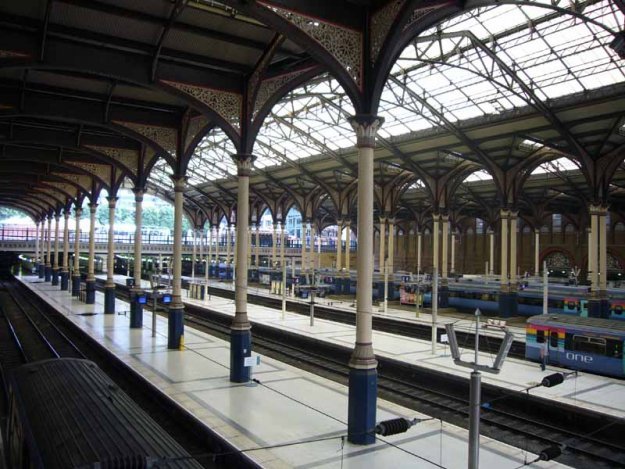19th century British Architecture

|
The Industrial Revolution, underway by the middle of the 18th century and emerging first in England, is often cited as the single most important development effecting architecture in the modern world. The harnessing of coal and steam energy combined with new mechanized technologies and industrial materials, especially iron, steel and glass, brought sweeping changes throughout the fabric of society. Architectural commissions from ecclesiastical, royal and noble patrons were replaced by a new class of public authorities and private patrons, the leaders of the modern industrialized state. A changed societal structure required new types of buildings unimagined in a previous age: government offices, banks, hospitals, theaters, libraries, educational institutions, museums, railroad stations, factories, warehouses, commercial buildings such as department stores and a whole range of new types of housing for every social class from factory workers to industrial barons required innovative engineering and design solutions, mostly within rapidly evolving urban settings. Supporting these fundamental changes in society was the intellectual and aesthetic developments of the Enlightenment a broad trend in 18th-century European philosophy fostering rational thought in religious, political and economic matters and the idea of promoting progress for a broad swath of mankind. To be sure, many 19th-century buildings appear to lie in a direct line of development from the preceding age. The Classical style of Robert Smirke’s British Museum in London, begun in 1824, might have been recognizable to the citizens of Periclean Athens, yet the very idea to construct an immense structure housing an encyclopedic collection of cultural artifacts reflects the growth of public projects to benefit the growing middle class. The same observations could be applied to the Altes Museum in Berlin designed by Karl Friedrich Schinkel during the same years, all part of the expansion of major European capitals during the period and the emergence of modern culture and social values. In some respects, Notre-Dame, the medieval cathedral of Paris, was supplanted as the centerpiece of the city by the new Opera, designed by Charles Garnier in 1861 and opened in 1875. The Paris Opera represents perhaps better than most buildings of the time, the complex forces at work by mid-century. Drawing confidently on a wealth of Renaissance and Baroque elements fused into a style best described as Beaux-Arts, the Paris Opera frames a new conception of public theater and spectacle meshing seamlessly from audience to stage. The emergence of technological developments in 19th-century building systems, most importantly cast iron used for the superstructure of many buildings, seemed as swift, startling and unrelenting as digital technology seems in the 21st-century. Exemplifying this development is the Bibliotheque Sainte-Genevieve in Paris, designed by Henri Lebrouste and built from 1842 to 1850. The reading room recalls the monastic libraries of Medieval and Renaissance Italy, but the enormous scale is possible only by exploiting ironwork for two rows of arches supported by stone outer walls and a line of iron columns in the center of the space. |
More spectacular structures of iron, such as the Eiffel Tower and the vast steam-filled railroad stations of Paris and London, demonstrate the engineering marvels of the period and the optimism of a new age. The recent renovation of the Great Court at the British museum makes for an interesting postscript highlighting both 19th-century and 21st-century architectural and societal goals. In the 1850’s the Great Court of the museum building was filled with a circular reading room designed with communal reading tables radiating from the central distribution desk, the encircling wall stuffed with an astounding variety of reference books, and covered by a light-filled dome. Over the years, the area around the exterior of the reading room became encrusted with a labyrinth of small offices obscuring the structure. In the late 1990’s, this warren of rooms was demolished and replaced by an elegant new public reception area designed by the architectural firm of Foster and Partners featuring a vault of glass panels supported by a network of aluminum tubes complementing the vault of the reading room. The renovation reinstated the reading room as the centerpiece of the central court but, alas, the British Library was moved to a new building on Euston Road leaving the great 19th-century structure as a fitting monument to the social, political and cultural ideals of its century. Postmodernism has taken hold, even in the heart of this great building that owes its existence to the philosophy of the Enlightenment and the changes it wrought in early 19th-century Europe. |






